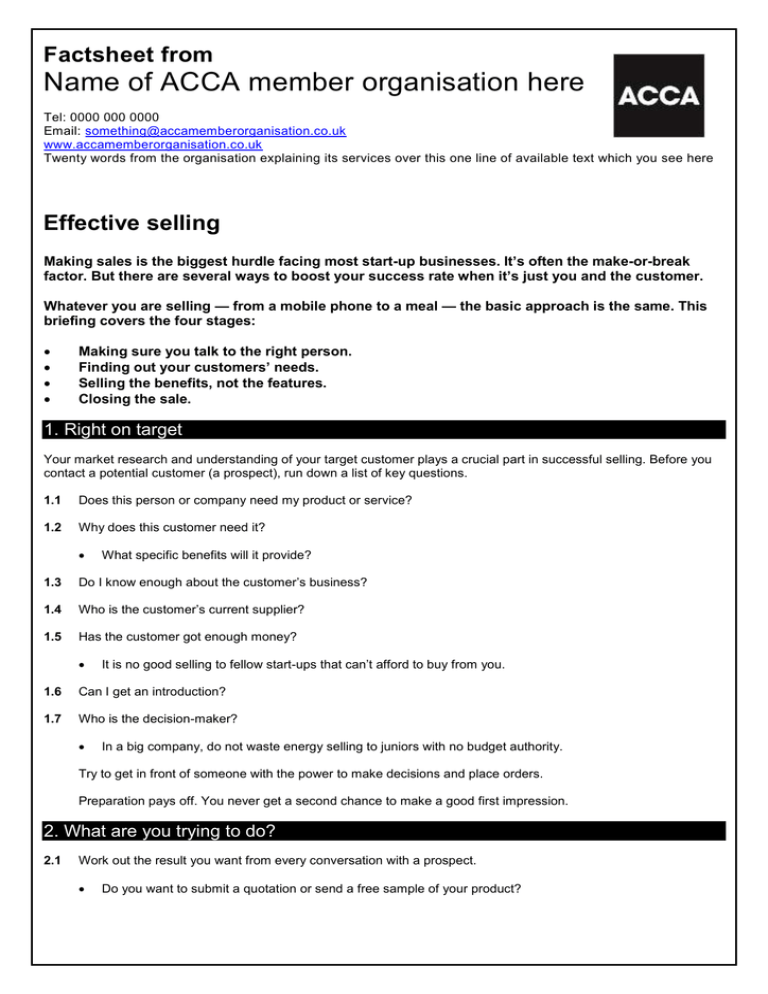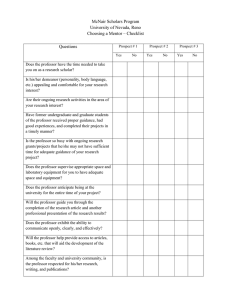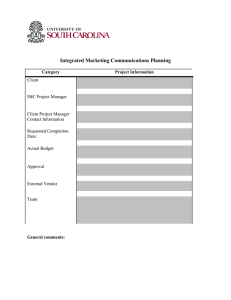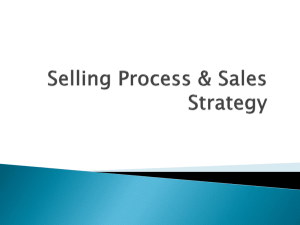
Factsheet from
Name of ACCA member organisation here
Tel: 0000 000 0000
Email: something@accamemberorganisation.co.uk
www.accamemberorganisation.co.uk
Twenty words from the organisation explaining its services over this one line of available text which you see here
Effective selling
Making sales is the biggest hurdle facing most start-up businesses. It’s often the make-or-break
factor. But there are several ways to boost your success rate when it’s just you and the customer.
Whatever you are selling — from a mobile phone to a meal — the basic approach is the same. This
briefing covers the four stages:
Making sure you talk to the right person.
Finding out your customers’ needs.
Selling the benefits, not the features.
Closing the sale.
1. Right on target
Your market research and understanding of your target customer plays a crucial part in successful selling. Before you
contact a potential customer (a prospect), run down a list of key questions.
1.1
Does this person or company need my product or service?
1.2
Why does this customer need it?
What specific benefits will it provide?
1.3
Do I know enough about the customer’s business?
1.4
Who is the customer’s current supplier?
1.5
Has the customer got enough money?
It is no good selling to fellow start-ups that can’t afford to buy from you.
1.6
Can I get an introduction?
1.7
Who is the decision-maker?
In a big company, do not waste energy selling to juniors with no budget authority.
Try to get in front of someone with the power to make decisions and place orders.
Preparation pays off. You never get a second chance to make a good first impression.
2. What are you trying to do?
2.1
Work out the result you want from every conversation with a prospect.
Do you want to submit a quotation or send a free sample of your product?
2.2
Do you want to arrange a meeting?
Even if you get a rejection, keep building up your information on each prospect. It will help you next time.
3. Reach the decision-maker
It’s unlikely that you will be able to speak to a decision-maker immediately unless the target business is very small.
Many managers will not take unsolicited sales calls.
But if you handle your initial contact correctly, you can raise your chances of speaking to the right person.
3.1
Greet the initial person.
3.2
Try to get their name early on, as this will help you next time you call.
Be open and honest. Explain who you are.
Sounding polite and cheerful will get you a long way.
3.3
Show knowledge of the company, eg “I would like to discuss the garden sheds your company sells”.
3.4
Show a benefit, eg “I think Mr X will want to speak with me because we have a shelving product that
compliments your sheds”.
Ideally, make the contact worry that they may miss an opportunity by not speaking to you.
3.5
Ask for help, eg “I am trying to get an appointment with Mr X. Can you help me?”
3.6
Ask for an appointment at a definite time.
3.7
If you are asked to put something in the post, react in a constructive way.
Explain that it would help to talk to the right person first, so you can send tailored information.
4. Creating interest
4.1
When you open a sale, establish right away that you are not wasting the prospect’s time.
4.2
Make it clear you believe there are genuine benefits for the customer.
It helps to start by asking a series of questions which can only be answered “Yes”.
This creates a positive momentum and helps you involve the prospect while progressing to the next thing you want to
say.
Compare these examples:
Bad opening: “I do injection moulding and I want to tell you about my services.”
Response: “I’m sorry, I’m not interested.”
Good opening: “I have a small injection moulding shop and I gather you use plastic mouldings. Is that
correct?”
Response: “Yes, we do.”
5. Do they need your product?
Compare these two statements, with two different approaches to selling:
2
Salesman 1: “This PC has lots of RAM. I recommend it.”
Salesman 2: “This PC has enough memory for you to handle word processing and the management accounts. It’s just
what you need.”
Salesman 1 is selling the product, but his sales pitch will be the same for every customer.
Salesman 2 has found out the prospect’s needs, so he can then sell the benefits of his product. He will sell many more
PCs than Salesman 1.
5.1
Use open questions (questions that cannot be answered “Yes” or “No”) when investigating potential customers’
needs.
5.2
Listen carefully to what the prospect says.
5.3
Top sales people talk little and listen a lot.
Make sure your prospects understand their own needs and opportunities.
5.4
“What garden accessories do you currently sell?”
“Why do you buy them from Germany?”
“What are you looking for when you buy this type of shelving?”
“So when your customers buy sheds, they don’t buy shelves for them. If they did, what would the extra sales
be worth?”
Confirm that the need is important enough to merit taking action.
6. Emphasise the benefits
Once you know what the prospect is looking for, you can offer the solution — your product.
If a prospect is interested but undecided, remove any remaining doubts by explaining why your product is ideal.
6.1
Sell the benefits, not the features.
Feature: Teflon coating on saucepan. Benefit: “To wash it up, just wipe it.”
A feature is an attribute of the product or service, such as size or design. A benefit is what the feature can do for
the customer. But it is only relevant if it is something that particular customer wants.
6.2
Match benefits to the prospect’s needs.
6.3
Quantify the benefits.
6.4
Photos, cuttings, research reports and testimonials all help to reinforce the point.
Mention customers and their comments.
6.6
“Insulating the loft would save you £75 a year. It will pay for itself in three years.”
Produce evidence to back up your claims.
6.5
“As you hate gardening, I’m sure you will appreciate the paved back garden.”
“Customers tell me our umbrellas last longer because they are so well-made.”
Be prepared to discuss rival products, but provide proof of the advantages you offer.
3
For example: “Independent studies prove we can give you lower lifetime running costs.”
Under the Business Protection from Unfair Trading Regulations it is an offence for businesses to advertise in
a way that: compares products or materials that are not designed for the same purpose; confuses traders as
to the advertiser and the competitor; or presents imitations of products bearing a trade mark.
7. Objections to the sale
You should welcome objections as a sign that the prospect is taking you seriously. You will soon come to recognise the
common themes:
7.1
There is an established relationship with an existing supplier.
7.2
Gently make an opening for yourself. “If you have a good supplier, it makes no sense to change unless we
can beat their offer. My customers tell me our pricing, quality and service are very competitive. Why not try
us out with one small order?”
The customer likes your product, but thinks it is too expensive.
Explain that your product is actually good value and demonstrate why.
Often a customer whose mind is made up just wants to be reassured the decision is right before giving you the
order.
7.3
Sell the full package you offer, such as your after-sales service and inclusive delivery.
Keep stressing the benefits of your product.
Doubts are voiced about quality and whether you can achieve it consistently.
Ask: “What are the specifications you would expect us to meet?”
Then briefly explain how your product does meet the specification, your company’s rigorous quality control
systems and good reputation, and so on.
7.4
The customer pleads lack of money.
Probe to see if this is the real objection.
Ask: “If you did have the money available now, would you buy it?”
Show how a credit arrangement, payment by instalments or some other financing approach could make the
deal possible.
Demonstrate the savings the customer would make — and how quickly they would feed through.
8. Handling objections
Isolate and test the objection by asking if the prospect has any other concerns about your product. Then deal with it.
8.1
Acknowledge the validity of the prospect’s concern: “You’re right to ask about quality.”
8.2
Tackle the objection directly and from the customer’s perspective. Do not simply re-hash your sales pitch.
8.3
Talk about the specific benefits of your product as they relate to the specific needs of this individual customer.
9. Closing the sale
9.1
Don’t expect your customer to do the work of closing the sale for you.
4
9.2
Once you realise the prospect is ready to buy, stop selling.
9.3
Check and confirm what has been agreed.
9.4
“So, you have chosen the blue one.”
Close the sale:
9.5
If you do not stop, you may go on to talk yourself out of a sale.
Use an upbeat, positive manner.
The ‘alternatives’ close is also effective. “Do you prefer the blue one or the red?”
Some people find it hard to close a sale, even when a customer is eager to buy.
The simplest way of all is to ask: “Can I take your order now?”
Once you have asked for the sale, resist the temptation to say any more.
Your silence encourages the customer to think things through and reach a decision.
9.6
When there is just one objection left and you have checked that any others have been answered (see 8), you can
use a technique known as the conditional close.
Ask: “If I can guarantee to get the delivery date brought forward to meet your schedule, will you place the
order now?”
A hesitant buyer can often be won over by this reassurance that the one remaining stumbling block has now
been resolved.
10. Legal obligations
Businesses in all sectors are banned from using unfair commercial practices to market and sell to customers.
10.1 Consumer Protection from Unfair Trading Regulations.
Commercial practices are deemed unfair if they mislead (by action or omission) or are aggressive (by
intimidating or exploiting consumers).
The regulations have banned 31 aggressive and misleading sales practices including: falsely stating that a
product will be available for a very limited time only; exaggerating personal security risks in order to sell
safety products; and refusing to leave a customer's house until they sign a contract.
For a full list of the 31 banned practices, download a free guide at www.berr.gov.uk/files/file46035.pdf
Businesses that fail to comply with the regulations risk fines of up to £5,000 for each offence. Serious or
repeated breaches could result in criminal prosecution.
10.2 Consumer Credit Act.
Consumers who sign a credit agreement at have the right to a fourteen-day cooling-off period.
Consumers can settle the credit agreement at any time.
Consumers can make claims against the supplier or credit provider for faulty goods.
Consumers are entitled to at least one statement of their account per year. You are also obliged to send a
notice to any consumer who falls behind with their payments.
10.3Consumer Contracts (Information, Cancellation and Additional Charges) Regulations 2013.
Consumers who agree to make a purchase worth more than £42 during a visit by a trader to their home or
place of work have the right to a fourteen-day cooling-off period.
5
Getting the appointment
Phoning to fix an appointment need not be daunting if you take a systematic approach.
A.
Check you are speaking to the right person, introduce yourself and establish a basis for talking as soon as you
can.
B.
Provide a persuasive reason for meeting and try to confirm a time and date.
C.
“Did you receive my letter?”
“Your friend X suggested I call you.”
“Did you see the article about our company in Y magazine?”
Pick one key benefit and tailor the way you present it to suit the customer’s immediate needs.
Start by suggesting a date that suits you, and let the customer come back with an alternative if this is not
convenient.
Aim to keep the conversation moving forward. Here are some routine brush-offs, and how you might respond.
“Let me think about it.”
“Of course. What is it that particularly concerns you?”
“Put something in the post to me and I’ll look at it.”
“OK. Which type of product are you particularly interested in?”
“I have to go into a meeting now.”
“Fine. I’ll send you a letter following up on our discussion.”
D.
If you get an outright brush-off, do not take it personally. Try to pin down why the prospect is not interested.
Is it just that the timing is wrong?
Should you call back in six months?
Further help
Last updated 01.07.14
© Atom Content Marketing 2014. ISSN 1469-0470. All rights reserved. No part of this publication may be reproduced or transmitted without the
written permission of the publisher. This publication is for general guidance only. The publisher, expert contributors and distributor disclaim all liability
for any errors or omissions. Consult your local business support organisation or your professional adviser for help and advice.
6




